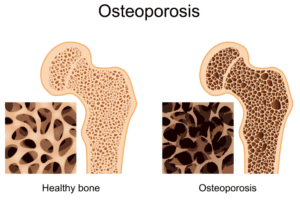Osteoporosis prevention and management – important news for all adults!
What is osteoporosis?
Osteoporosis is a condition where the bones lose minerals such as calcium which causes them to become fragile and brittle, and they are thus more prone to fracture than normal bone. Osteoporosis can affect any bone in the body, but is most common in the spine, hips and wrists. Usually no symptoms will be felt until a fracture (break or crack in the bone) occurs. Often these fractures can occur with minimal trauma.

1 in 2 women and 1 in 3 men in Australia over 60 years old will have an osteoporotic fracture.
What causes osteoporosis?
Our bodies are constantly building new bone, and removing old bone. In childhood, more bone is built than is removed so our bone mass grows, as we get into our 30’s and 40’s more bone is removed than is being added, so our bone mass can start to decline. Another cause of osteoporosis is a lack of certain hormones such as estrogen in women and androgen in men. Menopause, which causes a lowering of womens estrogen can be a contributing factor to osteoporosis.
Other factors which can contribute to osteoporosis include lack of calcium and vitamin D intake, lack of weight bearing exercise, overuse of corticosteriods, thyroid problems, lack of muscle use (inactivity), cigarette smoking, anorexia or bulimia, heavy alcohol consumption, rheumatoid arthritis and bone cancer.
There are not usually any symptoms of osteoporosis until you have a fracture, in this case the fracture (often from relatively mild trauma) will give pain or deformity. Deformity often happens when the weaked vertebra in the spine are crushed and a hump in the spine starts to form, i.e. the back starts to appear hunched over (often called a dowagers hump).
What can I do to prevent osteoporosis or slow its progression?
Osteoporosis prevention and management can take many forms
- Reduce alcohol consumption
- Quit smoking (or reduce intake of tobacco smoke)
- Improve your diet – ensure you have a balanced diet of vitamins and minerals including calcium and vitamin D (vitamin D can also be obtained with exposure to sunlight)
- Maintain a healthy weight – being underweight can lead to osteoporosis
- Increase weight bearing activity – such as weights, walking, running, body resistance training. Peak bone mass is usually achieved by 25 years of age, so it is important to achieve strong bones by that age so that bones will stay strong later in life. Burleigh Physio is now offering the ONERO exercise program – based on research proving that specific loaded exercise improves bone density.
- Reduce intake of soft drink – some studies have shown that soft drinks may increase risk of osteoporosis
- Consult with your GP – your GP can order a bone mineral density test if warranted to check for signs of osteoporosis, if you already have osteoporosis your GP can prescribe medication to help maintain or improve your bone mass, however you still need to exercise and eat correctly.
How can Physiotherapy help?
Physiotherapists as movement and exercise experts can advise on the best exercise program to undertake and will take into consideration any existing injuries or concurrent conditions.
Gold Coast Physiotherapy and Allied Health at Burleigh Heads and Broadbeach 07 5535 5218







